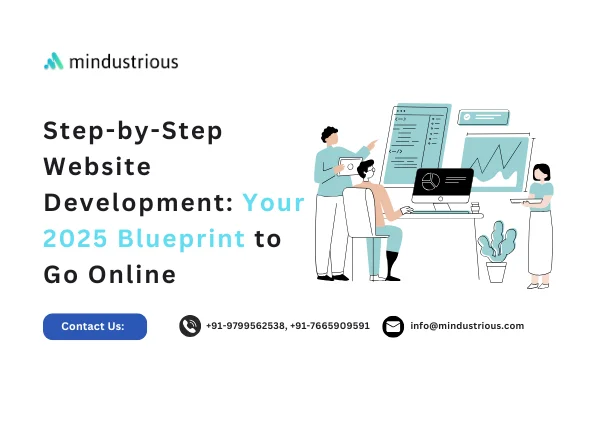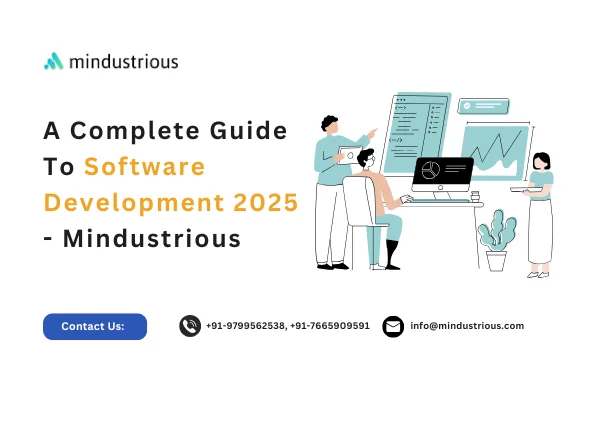Introduction of Mobile App Development Guide 2025:
Initially, it may appear that building a mobile app is going to be a hard thing, but if you divide it into manageable steps, you’ll easily find it a lot more approachable. Whether you’re targeting cross-platform mobile app development or aiming to integrate AI-driven features, this guide simplifies the process. As an expert in Flutter app development and mobile-first SEO strategies, I’ll walk you through the essential steps to create apps that align with 2025 mobile app trends. We’ll also include Flutter code examples to help you build faster. If you need professional mobile app development services, contact Mindustrious for custom AI/ML integration or SEO-friendly app solutions.
1. Create an App Concept
The first step however, is understanding what your app will actually do. What problem does it solve? Who will use it? In order to formulate a solid concept, you have to ask yourself such questions.
For example, if you are constructing a To-Do List App. Perhaps the idea is to assist users to get busy in their daily chores in a more effective manner. Your target audience might be the US or worldwide population that wants to control a day. Before this you can do this activity.
The first step is defining your app’s purpose. Ask:
- What problem does it solve?
- Who will use it? (target audience analysis)
- How does it align with 2025 mobile app trends like voice search optimization or AI-driven personalization?
Example Concept
App Name: QuickTask
Purpose: Help users manage tasks with AI-powered reminders (e.g., NLP-based voice inputs).
Target Audience: Busy professionals seeking productivity app solutions.
2. Decide on the Monetization Model
Choose a model that fits 2025 mobile app monetization trends: or Before diving into development, think about how you want to make money (if that’s your goal). Here are some popular models:
- In-app purchases (e.g., unlock AI-driven analytics).
- Hybrid monetization (ads + subscriptions).
- Ethical AI integration (e.g., premium features for data privacy).
Let’s say you choose the in-app purchase model. If you’re building a fitness app, users might unlock special workout plans by paying extra.
3. Plan the Features
Focus on core features and user experience (UX) best practices: or Now that you have a clear concept and monetization plan, you’ll need to define the core features of your app. Focus on what’s essential.
For a To-Do List App, essential features might include:
- Task creation with voice-to-text functionality (optimized for voice search SEO).
- AI-driven deadline predictions (using machine learning).
- Cross-platform compatibility (Flutter for iOS/Android).
Here’s a basic coding example in Flutter to create a task list screen:
|
import 'package:flutter/material.dart';
void main() { runApp(MyApp()); }
class MyApp extends StatelessWidget { @override Widget build(BuildContext context) { return MaterialApp( home: TaskListScreen(), ); } }
class TaskListScreen extends StatelessWidget { final List<String> tasks = ["Buy groceries", "Complete homework", "Call mom"];
@override Widget build(BuildContext context) { return Scaffold( appBar: AppBar(title: Text("Task List")), body: ListView.builder( itemCount: tasks.length, itemBuilder: (context, index) { return ListTile( title: Text(tasks[index]), trailing: Icon(Icons.check_box_outline_blank), ); }, ), ); } } |
In this code, we're creating a simple list of tasks and displaying them in a list view.
4. Design the User Interface (UI)
The UI design is a key part of your app. It needs to be user-friendly and visually appealing. Think about colors, fonts, and how users will interact with the app.
For a To-Do list app, you might want buttons to add tasks and mark tasks as completed. The layout should be clean and intuitive. Let’s look at a UI design example in Flutter:
- Use responsive layouts for all screen sizes.
- Implement dark mode compatibility (a 2025 UI trend).
- Add semantic labels for accessibility (boosts E-A-T compliance).
Flutter UI Example:
|
Scaffold( appBar: AppBar(title: Text("Task List")), body: ListView.builder( itemCount: tasks.length, itemBuilder: (context, index) { return ListTile( title: Text(tasks[index]), trailing: IconButton( icon: Icon(Icons.check_circle), onPressed: () { // Mark task as complete }, ), ); }, ), floatingActionButton: FloatingActionButton( onPressed: () { // Add a new task }, child: Icon(Icons.add), ), ); |
This Flutter widget adds a floating action button to add new tasks. When the user taps on it, they can create a new task.
5. Develop the App
Once the design is ready, it’s time to build the app. For this step, you’ll write the actual code that makes the app functional. Let’s say you choose Flutter for cross-platform development (works on both iOS and Android).
Here’s a simple example of how you could add a task in Flutter. or For cross-platform development, use Flutter’s hybrid rendering to improve app performance and SEO crawlability.
Code Example:
|
TextEditingController taskController = TextEditingController();
void addTask() { setState(() { tasks.add(taskController.text); // Add task to list taskController.clear(); // Clear the input field }); }
TextField( controller: taskController, decoration: InputDecoration(hintText: "Enter new task"), ), IconButton( icon: Icon(Icons.add), onPressed: addTask, ) |
This allows users to input a new task and add it to the list. The text field accepts input, and the icon button triggers the action to add the task.
6. Conduct Quality Assurance (QA)
Testing is a critical step! Ensure everything works properly and that there are no bugs. Test on multiple devices and operating systems.
Test for:
- App performance metrics (LCP, FID, CLS).
- Mobile app security best practices (e.g., data encryption).
- Voice search compatibility (test with tools like Google Assistant).
- Does the app crash or freeze at any point?
- Are all features working as expected?
- Is the app responsive on different screen sizes?
Use AI-driven testing tools like Appium, Flutter Driver for Flutter apps for automation.
7. Launch and Gather Feedback
Finally, launch your app on platforms like the Google Play Store or Apple App Store. Once live, gather user feedback to improve your app. And do Optimize for App Store Optimization (ASO) with keywords like “AI-powered task manager” or “Flutter productivity app”. Post-launch, use AI sentiment analysis to process user feedback.
In the early stages, expect to get bug reports and suggestions for new features. Be ready to update your app regularly!
Wrapping Up
Building a mobile app is a step-by-step journey, and with the right guidance, you can successfully create an app that is both useful and enjoyable. Whether you're using Flutter for cross-platform development or any other framework, always keep your users’ needs at the center of your design and development process.
By following these seven steps — from creating mobile apps concept to launching it and gathering feedback — you'll be well on your way to success. Happy coding, and enjoy the process of bringing your ideas to life!



